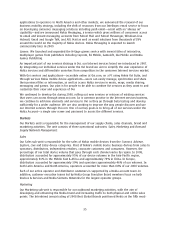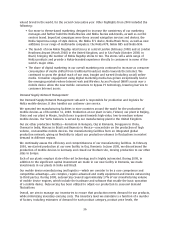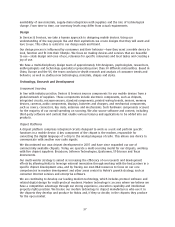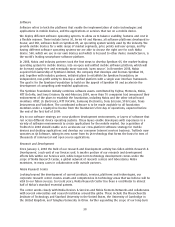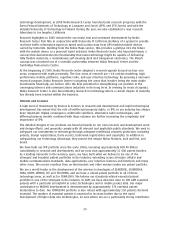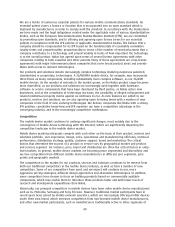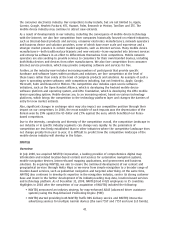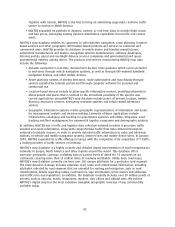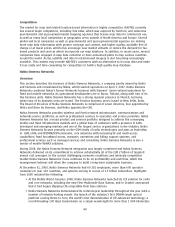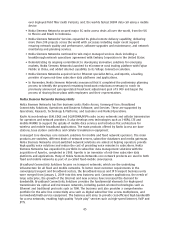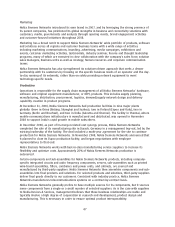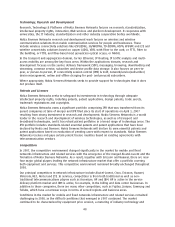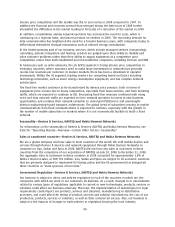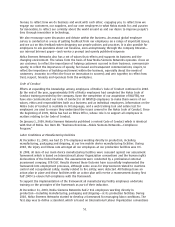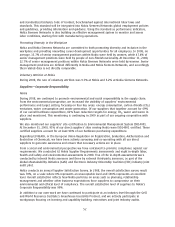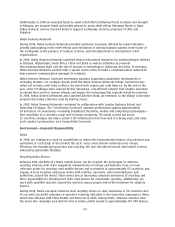Nokia 2008 Annual Report Download - page 45
Download and view the complete annual report
Please find page 45 of the 2008 Nokia annual report below. You can navigate through the pages in the report by either clicking on the pages listed below, or by using the keyword search tool below to find specific information within the annual report.Competition
The market for map and related locationbased information is highly competitive. NAVTEQ currently
has several major competitors, including Tele Atlas, which was acquired by TomTom, and numerous
governmental and quasigovernmental mapping agencies that license map data for commercial use,
as well as many local competitors in geographic areas outside of North America and Europe. Several
global and local companies as well as governmental and quasigovernmental agencies are making
more map data information with greater coverage and content, and higher quality, available free of
charge or at lower prices, which may encourage new market entrants or reduce the demand for fee
based products and services which incorporate our map database. In addition, in recent years, several
companies have engaged in map data collection or have announced plans to map various countries
around the world. Aerial, satellite and other locationbased imagery is also becoming increasingly
available. This content may provide NAVTEQ’s customers with an alternative to its map data and make
it less costly and timeconsuming for competitors to build a high quality map database.
Nokia Siemens Networks
Overview
This section describes the business of Nokia Siemens Networks, a company jointly owned by Nokia
and Siemens and consolidated by Nokia, which started operations on April 1, 2007. Nokia Siemens
Networks combined Nokia’s former Networks business with Siemens’ carrierrelated operations for
fixed and mobile networks. Its operational headquarters are in Espoo, Finland, along with two of its
five business units. Nokia Siemens Networks has a strong regional presence in Munich, Germany,
where two of its business units are based. The Services business unit is based in New Delhi, India.
The Board of Directors of Nokia Siemens Networks is comprised of seven directors, four appointed by
Nokia and three by Siemens, and Nokia appoints the CEO.
Nokia Siemens Networks provides wireless and fixed network infrastructure, communications and
networks service platforms, as well as professional services to operators and service providers. Nokia
Siemens Networks has a broad product and services portfolio designed to address the converging
mobile and fixed infrastructure markets and a global base of customers with a presence in both
developed and emerging markets and one of the largest service organizations in the industry. Nokia
Siemens Networks focuses primarily on the GSM family of radio technologies and aims at leadership
in: GSM, EDGE and WCDMA/HSPA networks; core networks with increasing IP and multiaccess
capabilities; fixed broadband access, transport, operations and billing support systems; and
professional services such as managed services and consulting. Nokia Siemens Networks is also a
vendor of mobile WiMAX solutions.
During 2008, the Nokia Siemens Network integration was largely completed and Nokia Siemens
Networks delivered on its commitment to achieve substantially all of the EUR 2 billion of targeted
annual cost synergies. In the current challenging economic conditions and intensely competitive
market Nokia Siemens Networks’ focus continues to be on profitability and cash flow, which the
management believes will allow the company to build a longterm sustainable business.
At December 31, 2008, Nokia Siemens Networks had 60 281 employees, more than 600 operator
customers in over 150 countries, and systems serving in excess of 1.5 billion subscribers. Highlights
from 2008 included the following:
• At the Mobile World Congress 2008, Nokia Siemens Networks launched its LTE solution for radio
and core networks, including the new Flexi Multimode Base Station, and in October announced
that it had begun shipping LTEcompatible Flexi base stations.
• Nokia Siemens Networks demonstrated its technological leadership throughout the year with a
number of industryleading events: the launch of the industry’s first DWDM single optical
platform serving Metro to Core; the world’s first demonstration of LTEAdvanced technology; a
recordbreaking 100 Gbps transmission on a single wavelength for more than 1 040 kilometers
44



